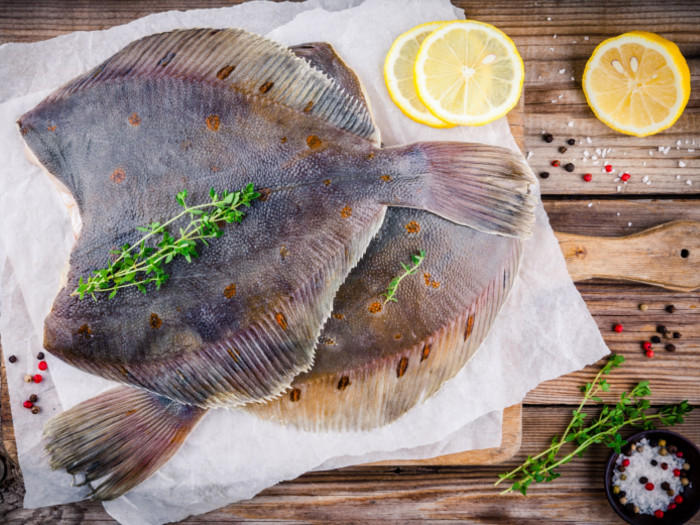Flounder fish is a tasty and healthy fish that should be added to any seafood lover’s diet. It can also offer a great many health benefits as discussed below.
What is Flounder Fish?
Flounder fish is the general name for a number of species of deep-sea flatfish in the suborder Pleuronectidae. Some species have camouflage properties, allowing them to lie on their side on the seafloor and avoid detection by predators. [1]
Most commonly found in North America, this saltwater fish is not as nutritionally dense as other popular fish in the kitchen, but it is very versatile in terms of how it can be cooked. The flavor of this fish is mild, with a touch of sweetness in some specimens, although the texture can range from delicate to firm, depending on the variety of flounder you’re eating. [2]

Ever wonder what the world would be like for a flounder? Photo Credit: Shutterstock
Serving Size : Nutrient Value Water [g] 84.63 Energy 70 Energy [kJ] 294 Protein [g] 12.41 Total lipid (fat) [g] 1.93 Ash [g] 1.22 Calcium, Ca [mg] 21 Iron, Fe [mg] 0.18 Magnesium, Mg [mg] 18 Phosphorus, P [mg] 252 Potassium, K [mg] 160 Sodium, Na [mg] 296 Zinc, Zn [mg] 0.32 Copper, Cu [mg] 0.02 Manganese, Mn [mg] 0.01 Selenium, Se [µg] 26.6 Thiamin [mg] 0.02 Riboflavin [mg] 0.02 Niacin [mg] 1.04 Pantothenic acid [mg] 0.19 Vitamin B-6 [mg] 0.1 Folate, total [µg] 5 Folate, food [µg] 5 Folate, DFE [µg] 5 Choline, total [mg] 65 Vitamin B-12 [µg] 1.13 Vitamin A, RAE [µg] 10 Retinol [µg] 10 Vitamin A, IU [IU] 33 Vitamin E (alpha-tocopherol) [mg] 0.63 Tocopherol, beta [mg] 0.01 Tocopherol, gamma [mg] 0.01 Tocopherol, delta [mg] 0.26 Vitamin D (D2 + D3), International Units [IU] 113 Vitamin D (D2 + D3) [µg] 2.8 Vitamin D3 (cholecalciferol) [µg] 2.8 Vitamin K (phylloquinone) [µg] 0.1 Vitamin K (Menaquinone-4) [µg] 0.2 Fatty acids, total saturated [g] 0.44 10:0 [g] 0 12:0 [g] 0.01 14:0 [g] 0.09 15:0 [g] 0.01 16:0 [g] 0.28 17:0 [g] 0 18:0 [g] 0.05 20:0 [g] 0 24:0 [g] 0 Fatty acids, total monounsaturated [g] 0.54 16:1 [g] 0.09 16:1 c [g] 0.09 17:1 [g] 0.03 18:1 [g] 0.36 18:1 c [g] 0.35 20:1 [g] 0.06 22:1 [g] 0 Fatty acids, total polyunsaturated [g] 0.37 18:2 [g] 0.05 18:2 n-6 c,c [g] 0.04 18:3 [g] 0.02 18:3 n-3 c,c,c (ALA) [g] 0.02 18:3 n-6 c,c,c [g] 0 18:4 [g] 0.01 20:2 n-6 c,c [g] 0.01 20:3 [g] 0.01 20:3 n-3 [g] 0.01 20:3 n-6 [g] 0 20:4 [g] 0.02 20:5 n-3 (EPA) [g] 0.14 22:4 [g] 0 22:5 n-3 (DPA) [g] 0.03 22:6 n-3 (DHA) [g] 0.11 Fatty acids, total trans [g] 0.01 Fatty acids, total trans-monoenoic [g] 0.01 16:1 t [g] 0 18:1 t [g] 0.01 22:1 t [g] 0 18:2 t not further defined [g] 0 Fatty acids, total trans-polyenoic [g] 0 Cholesterol [mg] 45 Tryptophan [g] 0.16 Threonine [g] 0.59 Isoleucine [g] 0.61 Leucine [g] 1.09 Lysine [g] 1.27 Methionine [g] 0.46 Cystine [g] 0.15 Phenylalanine [g] 0.51 Tyrosine [g] 0.48 Valine [g] 0.65 Arginine [g] 0.9 Histidine [g] 0.3 Alanine [g] 0.77 Aspartic acid [g] 1.38 Glutamic acid [g] 2.13 Glycine [g] 0.64 Proline [g] 0.49 Serine [g] 0.58 Sources include : USDA [3]
Flounder Fish Nutrition
When it comes to nutrition, flounder is composed of more than 80% water, so the nutrients aren’t as highly concentrated.
- An 8-ounce serving of flounder contains roughly 180 calories but boasts possibly more than 30 grams of protein. This is the most impressive aspect of this fish, as it provides more than 50% of the protein required each day. [4]
- The fish is very low in fat, with only 20% of that fat being of the saturated variety.
- This fish also provides a range of minerals and vitamins in moderate to low levels, including calcium, iron, and vitamin C.
Benefits
The benefits of eating flounder may include reducing cholesterol levels, protecting fetal health, and lowering inflammation, among others.
May Help Lower Cholesterol
Being possibly low in saturated fat, and possessing some omega-3 fatty acids, this fish is known to help lower overall cholesterol levels and protect heart health. [5]
May Help Decrease Inflammation
The nutrients and minerals in flounder fish have been linked to decreases in inflammation and the symptoms of arthritis.
Flounder in Our Daily Diet
Adding flounder to your daily diet is quite easy, as it can be sautéed, baked, broiled, fried or grilled. Due to the delicate nature of the flavor, this fish is a great source of protein that soaks up many of the flavors around it. It is particularly good when paired with steamed vegetables that have strong flavors.
